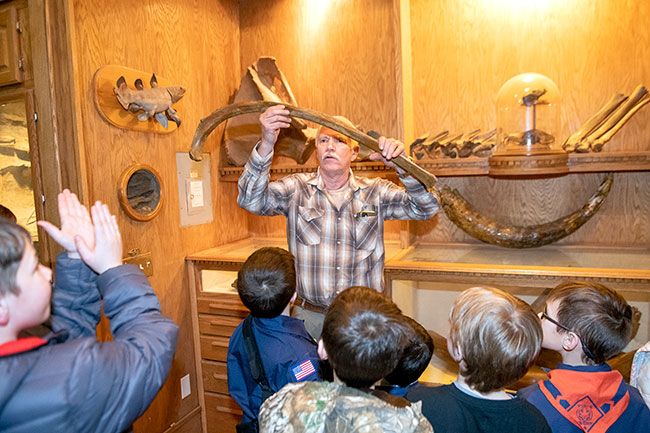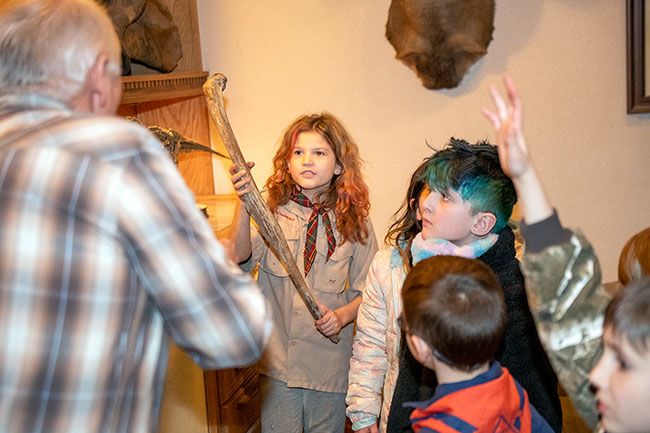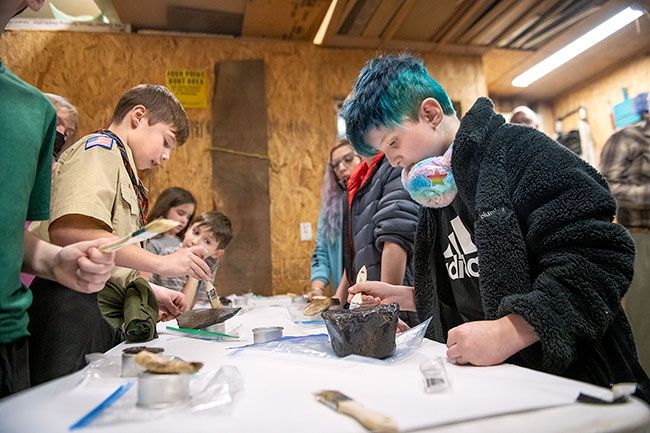Meeting the mammoth



As Cub Scouts from McMinnville Pack 454 examined bits of ancient beaver bone, pieces of mammoth teeth and sloth scales, fossil hunter Mike Full told them he soon would show them what the animals looked like when they roamed the Yamhill River valley.
“Photos?” one of the Scouts asked, forgetting that the Pleistocene Era mammoths predated photography by a good 55,000 to 65,000 years.
Eleven members of the pack, ranging from kindergarten through fifth grade, crowded around the collection of fossils this week. They ooh-ed and ahh-ed as Full showed them the mammoth teeth, as big as the Scouts’ tennis shoes, and a rib long enough to be an adult’s cane.
Both are parts of the McMinnville mammoth, an animal that died about 65,000 years ago when it was 47 to 50 years old, he said. Over the centuries, the bones became petrified as the soft material was replaced by minerals.
Full and other members of the Willamette Valley Pleistocene Project have been finding pieces of the mammoth and other members of its herd, from babies to adults, over the years on their trips along the Yamhill River.
Some types of mammoths had lots of hair, Full said; that’s the kind usually depicted in animated movies. The McMinnville type had a smoother hide, though.
Smooth or hairy, mammoths were “huge,” he said, much larger than their modern cousin, the elephant. Adult males stood 14 feet high at the shoulder and had tusks 14 or 15 feet long.
“It was taller than my mom,” Cub Scout Tristan Jackson marveled.
Her mother, Joanna Jackson, laughed. “Everything’s taller than me,” she joked.
If she’d been around at the time of the local mammoths, she might have needed to avoid being accidentally stepped on. But she wouldn’t have needed to worry about being eaten, since the mammoths used their big, ribbed molars to chew grasses and other plants.
The mammoths weren’t the only creatures grazing along the Yamhill River in ancient times, Full said. He and his fellow hunters have discovered numerous animals, including some predators.
He showed the Cub Scouts a mammoth bone that bears teeth marks, evidence that it had been chewed by a wolf. The wolf might not have killed it, though, he said; it might have been scavenging the carcass for food.
After seeing some fossils and pictures of the ancient animals, scouts got to help the Pleistocene Project. Each one picked up a small fossil and painted it with water-soluble preservative to stabilize it and keep it from falling apart.
Raen Frisbee chose a large, dark-colored fossil — a chunk about 6-by-4 inches. “I think it’s a foot,” he said as he dipped his paintbrush in the preservative and painted a thin layer onto every surface.
Fellow scout Mason Shipman disagreed with Ryan’s guess. “It’s definitely a joint between bones,” he said.
“Looks like a foot to me,” Raen said.
Other Cub Scouts picked smaller pieces, some long and thin, others more rounded. Pierce Egan guessed that his fossil was a piece of tusk ivory.
“Great guess,” Full said, telling them the piece is probably from an ulna or a clavicle.
Mason also made a good guess about the fossil he was preserving. “A canine on a mammoth?” he asked Full. “Like a tip that got sawed off.”
It is a tip, Full told him, “right off the top of a tusk.”
After the preservative dried on the fossils Mason, Pierce, Raen and the other Scouts had painted, volunteer George Freitag cataloged them in the Pleistocene Project’s archives.
They will be viewable, along with other fossils and information about the ongoing Pleistocene Project, on the organization’s website, willamettevalleypleistocene.com.











Comments